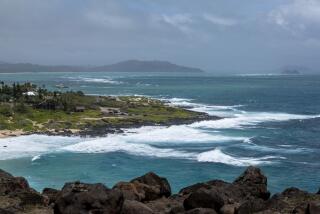Surfers Aren’t Put Off by Sharks
- Share via
KAHANA, Hawaii — Sam George can’t believe the audacity of surfers who seem to return to the water as soon as the blood of a shark attack dissipates -- even though he’s one of them.
“Once the blood cleared and the paramedics got off the beach, I’m as silly as the rest,” said George, San Clemente-based editor of Surfer magazine.
In Hawaii, surfer Will McInnis, 57, was killed by a shark April 7 off Maui’s western shore, the first confirmed shark fatality in the state in nearly a dozen years.
Police also were investigating the possibility of a shark attack in the disappearance of another surfer, Courtney Marcher, 22. Her board was found with its leash severed the same day that McInnis was attacked, but off Oahu’s North Shore, more than 100 miles away. She disappeared from a North Shore surf spot known as Velzyland on April 4.
The aftermath of McInnis’ death was typical of shark attacks in this state where surfing was born: Surfers were undeterred.
“It certainly makes you think about it,” said Barry Cox, 50, of Jackson, Wyo., who surfed the day of the attack and the next day, at Honolua Bay. But, he added: “If there’s waves there, you’ve got to go ride them.”
Cox’s rationale is echoed by surfer after surfer. They say a good wave is rare, so fear can’t get in the way of catching one.
The world’s most publicized recent shark-attack survivor, Kauai’s Bethany Hamilton, nearly died when her left arm was torn off Oct. 31, yet she spoke even from her hospital bed about returning to the ocean. As soon as she got the OK from her doctors -- less than a month later -- she was back riding the waves.
“Any surfer who’s already caught the bug, that will never deter them from surfing,” said Evan Slater, San Diego-based editor of Surfing magazine. “You’re willing to accept all the risks that are a part of it.”
In Hawaii, the sport eclipses pastime status. It is a culture all its own, with obsessed wave riders centering their lives around the rise of the tide.
Thousands of people of all ages in Hawaii surf, and thousands more flock from around the world to 1,600 sites on six islands to catch a wave. An average of four shark attacks are reported each year around Hawaii’s more than 200 miles of shoreline.
Sharks don’t play into surfers’ obsessions, but the possibility of attack always lurks just under the waves. Most surfers say they’ve seen a shark at least once, but many say they stayed in the water anyway.
“It’s their territory, so you just try not to fall on them,” said Alex Sansoucy, 25, of Montreal, who surfed off Maui the day after McInnis’ death.
Some of McInnis’ friends wanted to go surfing the day he was bitten, and at the very site of the attack -- just off of Kahana in an area known as S-Turns -- but state officials closed the beach. The next day, friends checked out the surf, but it was relatively flat, so they caught some waves south of here off Lahaina.
“I know that Will would have been down here with us if he was still here today,” said Kanamu Balinbin, 35, a friend who often surfed with the victim.
Balinbin was one of the few to say his friend’s death would change his surfing habits. He said he’ll never again surf alone at S-Turns.
Most surfers say they view an attack by a shark as something they have no control over. Some species are viewed by Native Hawaiians as sacred guardian spirits.
“If the shark wants to eat any one of us, they’re going to eat,” said Karen Gallagher, owner of North Shore Surf Camps on Oahu and a surfer for four decades. “You can’t outpaddle the shark.”
Regardless, surfers say that doesn’t matter. Their passion has only one antidote: surfing.
“Surfers build their whole life around being there and catching the wave,” George said. “Everything takes a backseat.”


